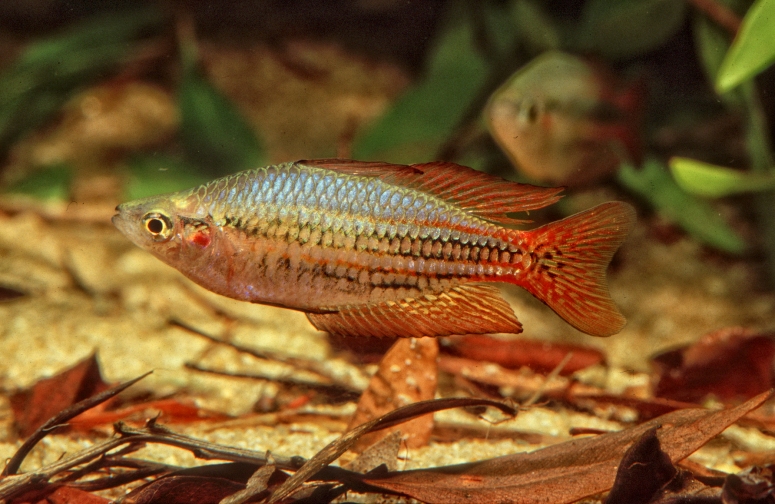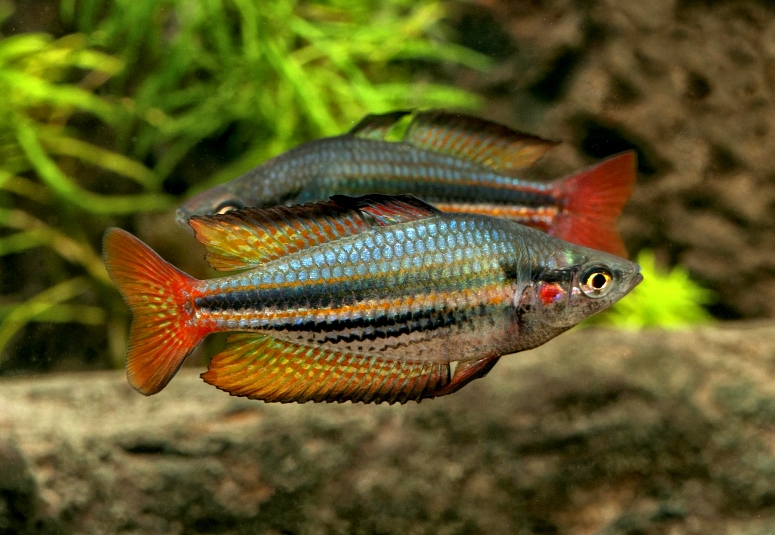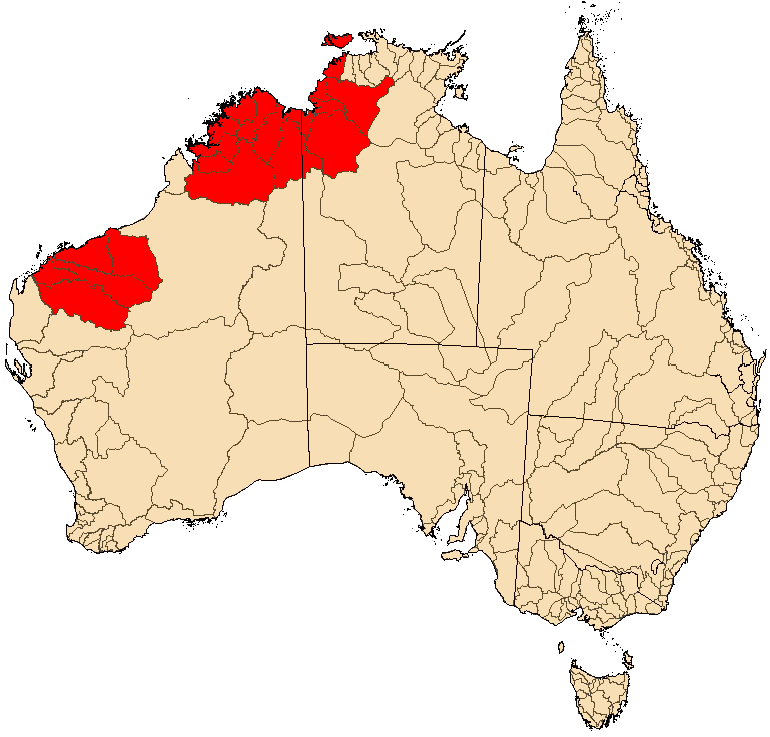|
 |
Melanotaenia australis [Drysdale River] - photo© Gunther Schmida |
(Castelnau, 1875)
Western Rainbowfish
Species Summary
Melanotaenia australis was first described by Castelnau as Neoatherina australis in 1875. The original type specimens were collected from Weeli Wolli, Hammersley Range, and Millstream homestead in Western Australia. In earlier days they were commonly known as the 'Westralian Sunfish'. In 1964 another species of rainbowfish collected from the Northern Territory was named Melanotaenia solata. After Gerald Allen's review of the rainbowfish family in 1980, these two species were considered as one and he placed them in the large "splendida" group as a sub-species, and named them Melanotaenia splendida australis, but genetic studies indicate that they are clearly distinct.
Melanotaenia australis can grow to a length of around 10 cm, but are more common at 8 cm or less. Males are usually much larger and deeper bodied than females. Their colouration, particularly the fins and intensity of the mid-lateral stripe, is highly variable depending on their geographic locality. This is mainly due to a rapid speciation in the rainbowfish group and is further enhanced by the degree of random morphological variation occurring among the various populations. Colouration generally consists of 1-2 broad, dark mid-lateral stripes and a series of narrow longitudinal stripes of orange-red corresponding with each scale row. The whole body has an overall sheen of iridescent purple or blue. Fins range from nearly colourless to deep red, or clear with red or green flecks. The second dorsal and anal fins have reddish orange rays with a yellow membrane and dark distal border. Gerry Allen notes that the real trademark of this species is the zigzagging blackish lines on the lower sides, just above the anal fins. The black mid-lateral line may be very prominent or scarcely apparent.
 |
Melanotaenia australis [Fish River, Daly River Basin] - photo© Gunther Schmida |
Males are easily distinguished from females by their brighter colours and longer and more elongated dorsal fin rays. In males, the spines of the first dorsal fin are usually extended and may lie well past the origin of the second dorsal when not erect. The posterior rays of the second dorsal and anal fins are extended caudally and in some species may extend past the origin of the caudal fin. With increasing age and length, the males may develop a very deep body with a distinct nuchal hump and angulated breast which increases the proportional body depth in some species to more than 40% of SL.
The body colouration of the females resembles the males but is much paler and lacks the dark mid-lateral band and zigzag stripes below it. In females, the first dorsal spines are short, not reaching the origin of the second dorsal. The posterior rays of the anal and second dorsal fin are not extended. They also have smaller rounded fins. Fish from the Drysdale River of Western Australia are generally smaller in statue and possess a distinctive double mid-lateral black stripe. Fish from the Pilbara region have a larger cheek spot area and greater number of lateral stripes than those from the Kimberley region, and within drainages, fish from downstream populations had a larger cheek spot and fewer coloured lateral stripes than those from upstream populations (Young et al. 2011).
Unlike many other rainbowfishes, Melanotaenia australis does not display the brightly coloured 'flashing nape band' that runs from the upper lip to the first dorsal fin whilst spawning. Males display by extending their dorsal and anal fins, while at the same time intensifying their colouration. The secondary sexual characteristics of fin development are not usually so pronounced in Melanotaenia australis as in the other species of rainbowfishes.
 |
Distribution Map |
Distribution & Habitat
Melanotaenia australis is one of the most common and widespread freshwater fish in river systems of north-western Australia; the Ashburton River forms the western and southern limit of its distribution. It is common in most streams of the Kimberley region and the northwestern Northern Territory. The Daly River has the most easterly population.
Melanotaenia australis is a stream dwelling rainbowfish mainly found around sub-surface vegetation, submerged logs, or branches in small tributary streams, but can also occur in swamps and lagoons. They are most commonly found in backwaters or along the shoreline where there is minimal flow and grassy vegetation. Their natural environment is subjected to seasonal variations with water temperature (22-36°C), pH (6.5-8.0), and hardness levels varying considerably. There is often a large fluctuation in water conditions between the dry and wet seasons.
 |
Melanotaenia australis [Ord River] - photo© Gunther Schmida |
Biology
Very little is known about the biology of this species in their natural environment. Most information is mainly based on aquarium observations. Spawning occurs from October to December, with females producing between 100 and 200 eggs. Spawned eggs are adhesive, negatively buoyant in freshwater and average 1.05-1.07 mm in diameter, are usually clear to light amber in colour and hang by a fine thread. Hatching occurs around 6 to 10 days depending on temperature. At 32 days after hatching, the length of the larval is about 10-11 mm and at 72 days 21-22 mm. Growth is fairly rapid reaching 2-3 cm in 10 to 12 weeks. Growth rates vary greatly with changes in temperature, feeding rate and densities. Under aquarium conditions with a water temperature of 26°C, Melanotaenia australis can attain a total length of 25 mm in 78 days.
Remarks
Melanotaenia australis show considerable variation in morphology across its known distribution and genetic studies suggest that there maybe more than one species in the Melanotaenia australis complex. Genetic studies in 2000 (McGuigan, et al.) found that M. australis is represented by two distinct lineages. These lineages are geographically restricted to Western Australia and the Northern Territory.
More recent studies (Phillips 2004) have shown that there is also a very large genetic difference between the Pilbara and east Kimberley populations of M. australis. These studies provide support for the separation of M. australis into two species: a southern one from the Pilbara area and the remaining northern populations. Pilbara populations are quite distinct and Allen (1995) noted that Pilbara populations lacked the mid lateral band that is prominent in many other M. australis populations. However, despite the research that has been undertaken to date, the specific status and distribution of M. australis still remains unclear.
.GS.jpg) |
Melanotaenia australis [De Grey River] - photo© Gunther Schmida |
Literature
Allen G.R. (1978) The rainbow fishes of northwestern Australia (Family Melanotaeniidae). Tropical Fish Hobbyist 26: 91-102.
Ivantsoff W., L.E.L.M. Crowley, E. Howe and G. Semple (1988) Biology and early development of eight fish species from the Alligator Rivers Region. Technical memorandum 22, Supervising Scientist for the Alligator Rivers Region, AGPS, Canberra.
McGuigan K., D. Zhu, G.R. Allen and C. Moritz (2000) Phylogenetic relationships and historical biogeography of melanotaeniid fishes in Australia and New Guinea. Marine and Freshwater Research 52: 713-23.
Phillips R. (2004) Population Structure of the Western Rainbowfish, Melanotaenia australis in the East Kimberley. Submitted in partial fulfilment of the Bachelor of Science (Honours) Degree School of Animal Biology The University of Western Australia.
Unmack P.J. (2002) Rainbowfish populations with unusual colour varieties within the range of Melanotaenia australis with miscellaneous observations on other fishes in the Darwin area. Fishes of Sahul. 16: 854-863.
Young M.J., L.W. Simmons and J.P. Evans (2011) Predation is associated with variation in colour pattern, but not body shape or colour reflectance, in a rainbowfish (Melanotaenia australis). Journal of Animal Ecology 80: 183-191.
Zhu D. B.G.M. Jamieson, A. Hugall and C. Moritz (1994) Sequence evolution and phylogenetic signal in control-region cytochrome b sequences of rainbowfishes (Melanotaeniidae). Molecular Biology and Evolution 11: 672-683.
Adrian R. Tappin
Updated April, 2013



|

